Microsoft Azure Architect Design v1.0
Question 1
HOTSPOT -
You are designing a software as a service (SaaS) application that will enable Azure Active Directory (Azure AD) users to create and publish surveys. The SaaS application will have a front-end web app and a back-end web API. The web app will rely on the web API to handle updates to customer surveys.
You need to design an authorization flow for the SaaS application. The solution must meet the following requirements:
-> To access the back-end web API, the web app must authenticate by using OAuth 2 bearer tokens.
The web app must authenticate by using the identities of individual users.

What should you include in the solution? To answer, select the appropriate options in the answer area.
NOTE: Each correct selection is worth one point.
Hot Area:
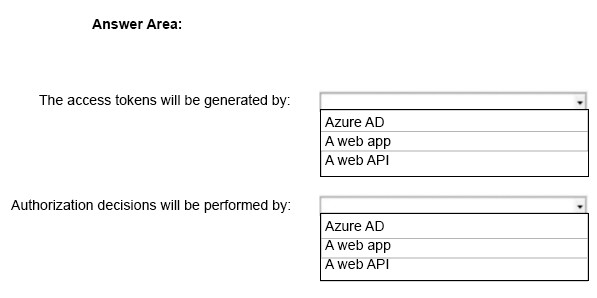
Answer : 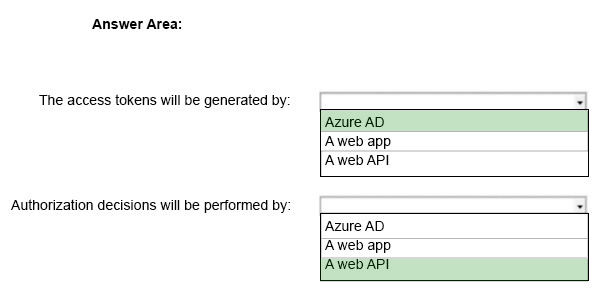
Reference:
https://docs.microsoft.com/lb-lu/azure/architecture/multitenant-identity/web-api https://docs.microsoft.com/en-us/azure/active-directory/develop/quickstart-v1-dotnet-webapi
Question 2
HOTSPOT -
You have five .NET Core applications that run on 10 Azure virtual machines in the same subscription.
You need to recommend a solution to ensure that the applications can authenticate by using the same Azure Active Directory (Azure AD) identity. The solution must meet the following requirements:
-> Ensure that the applications can authenticate only when running on the 10 virtual machines.
-> Minimize administrative effort.
What should you include in the recommendation? To answer, select the appropriate options in the answer area.
NOTE: Each correct selection is worth one point.
Hot Area:
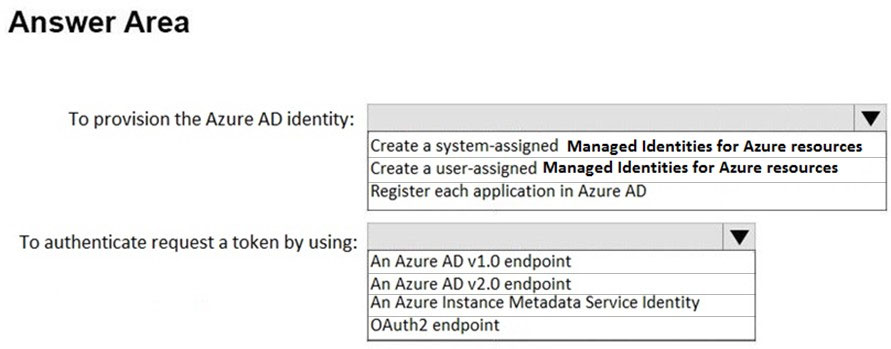
Answer : 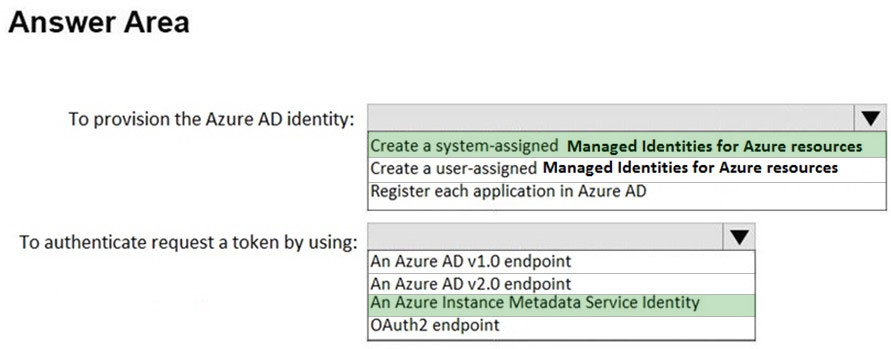
Explanation:
Box 1: Create a system-assigned Managed Identities for Azure resource
The managed identities for Azure resources feature in Azure Active Directory (Azure AD) feature provides Azure services with an automatically managed identity in Azure AD. You can use the identity to authenticate to any service that supports Azure AD authentication, including Key Vault, without any credentials in your code.
A system-assigned managed identity is enabled directly on an Azure service instance. When the identity is enabled, Azure creates an identity for the instance in the Azure AD tenant that's trusted by the subscription of the instance. After the identity is created, the credentials are provisioned onto the instance.
Box 2: An Azure Instance Metadata Service Identity
See step 3 and 5 below.
How a system-assigned managed identity works with an Azure VM
1. Azure Resource Manager receives a request to enable the system-assigned managed identity on a VM.
2. Azure Resource Manager creates a service principal in Azure AD for the identity of the VM. The service principal is created in the Azure AD tenant that's trusted by the subscription.
3. Azure Resource Manager configures the identity on the VM by updating the Azure Instance Metadata Service identity endpoint with the service principal client
ID and certificate.
4. After the VM has an identity, use the service principal information to grant the VM access to Azure resources. To call Azure Resource Manager, use role-based access control (RBAC) in Azure AD to assign the appropriate role to the VM service principal. To call Key Vault, grant your code access to the specific secret or key in Key Vault.
5. Your code that's running on the VM can request a token from the Azure Instance Metadata service endpoint, accessible only from within the VM
Reference:
https://docs.microsoft.com/en-us/azure/active-directory/managed-identities-azure-resources/overview
Question 3
A company named Contoso, Ltd. has an Azure Active Directory (Azure AD) tenant that is integrated with Microsoft Office 365 and an Azure subscription.
Contoso has an on-premises identity infrastructure. The infrastructure includes servers that run Active Directory Domain Services (AD DS), Active Directory
Federation Services (AD FS), Azure AD Connect, and Microsoft Identity Manager (MIM).
Contoso has a partnership with a company named Fabrikam, Inc. Fabrikam has an Active Directory forest and an Office 365 tenant. Fabrikam has the same on- premises identity infrastructure as Contoso.
A team of 10 developers from Fabrikam will work on an Azure solution that will be hosted in the Azure subscription of Contoso. The developers must be added to the Contributor role for a resource group in the Contoso subscription.
You need to recommend a solution to ensure that Contoso can assign the role to the 10 Fabrikam developers. The solution must ensure that the Fabrikam developers use their existing credentials to access resources.
What should you recommend?
- A. Configure an AD FS claims provider trust between the AD FS infrastructures of Fabrikam and Contoso.
- B. In the Azure AD tenant of Contoso, enable Azure Active Directory Domain Services (Azure AD DS). Create a one-way forest trust that uses selective authentication between the Active Directory forests of Contoso and Fabrikam.
- C. In the Azure AD tenant of Contoso, create guest accounts for the Fabrikam developers.
- D. In the Azure AD tenant of Contoso, create cloud-only user accounts for the Fabrikam developers.
Answer : B
Explanation:
Trust configurations - Configure trust from managed forests(s) or domain(s) to the administrative forest
-> A one-way trust is required from production environment to the admin forest.
-> Selective authentication should be used to restrict accounts in the admin forest to only logging on to the appropriate production hosts.
Reference:
https://docs.microsoft.com/en-us/windows-server/identity/securing-privileged-access/securing-privileged-access-reference-material
Question 4
You have a hybrid deployment of Azure Active Directory (Azure AD).
You need to recommend a solution to ensure that the Azure AD tenant can be managed only from the computers on your on-premises network.
What should you include in the recommendation?
- A. Azure AD roles and administrators
- B. a conditional access policy
- C. Azure AD Application Proxy
- D. Azure AD Privileged Identity Management
Answer : B
Question 5
You have an Azure Active Directory (Azure AD) tenant named contoso.com that contains two administrative user accounts named Admin1 and Admin2.
You create two Azure virtual machines named VM1 and VM2.
You need to ensure that Admin1 and Admin2 are notified when more than five events are added to the security log of VM1 or VM2 during a period of 120 seconds.
The solution must minimize administrative tasks.
What should you create?
- A. two action groups and one alert rule
- B. one action group and one alert rule
- C. five action groups and one alert rule
- D. two action groups and two alert rules
Answer : B
Question 6
You have an Azure Active Directory (Azure AD) tenant named contoso.com that contains several administrative user accounts.
You need to recommend a solution to identify which administrative user accounts have NOT signed in during the previous 30 days.
Which service should you include in the recommendation?
- A. Azure AD Identity Protection
- B. Azure Activity Log
- C. Azure Advisor
- D. Azure AD Privileged Identity Management (PIM)
Answer : D
Question 7
HOTSPOT -
Your organization has developed and deployed several Azure App Service Web and API applications. The applications use Azure Key Vault to store several authentication, storage account, and data encryption keys. Several departments have the following requests to support the applications:

You need to recommend the appropriate Azure service for each department request.
What should you recommend? To answer, configure the appropriate options in the dialog box in the answer area.
NOTE: Each correct selection is worth one point.
Hot Area:
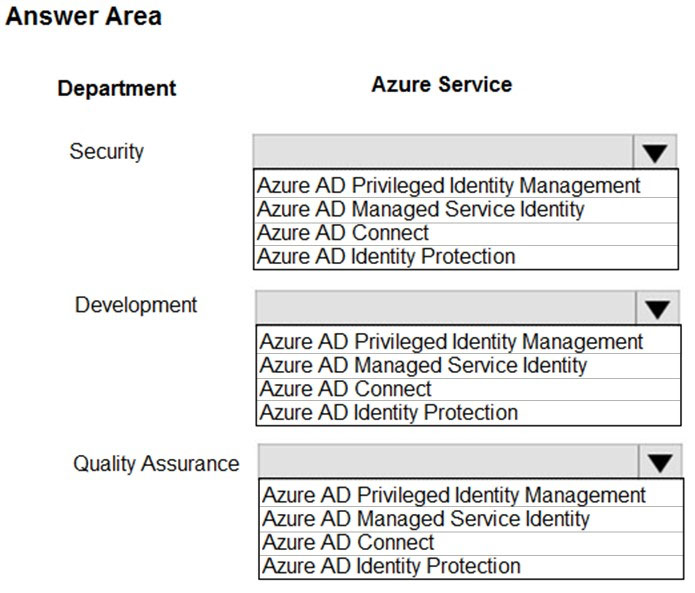
Answer : 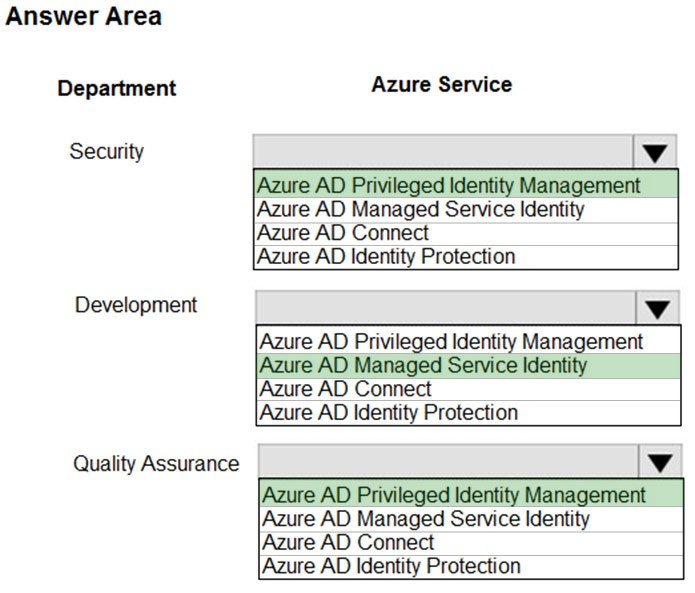
Question 8
You manage a single-domain, on-premises Active Directory forest named contoso.com. The forest functional level is Windows Server 2016.
You have several on-premises applications that depend on Active Directory.
You plan to migrate the applications to Azure.
You need to recommend an identity solution for the applications. The solution must meet the following requirements:
-> Eliminate the need for hybrid network connectivity.
-> Minimize management overhead for Active Directory.
What should you recommend?
- A. In Azure, deploy an additional child domain to the contoso.com forest.
- B. In Azure, deploy additional domain controllers for the contoso.com domain.
- C. Implement a new Active Directory forest in Azure.
- D. Implement Azure Active Directory Domain Services (Azure AD DS).
Answer : B
Question 9
Note: This question is a part of series of questions that present the same scenario. Each question in the series contains a unique solution that might meet the stated goals. Some question sets might have more than one correct solution, while others might not have a correct solution.
After you answer a question in this section, you will NOT be able to return to it. As a result, these questions will not appear in the review screen.
You have an Azure subscription named Project1. Only a group named Project1admins is assigned roles in the Project1 subscription. The Project1 subscription contains all the resources for an application named Application1.
Your company is developing a new application named Application2. The members of the Application2 development team belong to an Azure Active Directory
(Azure AD) group named App2Dev.
You identify the following requirements for Application2:
-> The members of App2Dev must be prevented from changing the role assignments in Azure.
-> The members of App2Dev must be able to create new Azure resources required by Application2.
-> All the required role assignments for Application2 will be performed by the members of Project1admins.
You need to recommend a solution for the role assignments of Application2.
Solution: In Project1, create a network security group (NSG) named NSG1. Assign Project1admins the Owner role for NSG1. Assign App2Dev the Contributor role for NSG1.
Does this meet the goal?
- A. Yes
- B. No
Answer : B
Explanation:
You should use a separate subscription for Project2.
Question 10
HOTSPOT -
You manage a network that includes an on-premises Active Directory Domain Services domain and an Azure Active Directory (Azure AD).
Employees are required to use different accounts when using on-premises or cloud resources. You must recommend a solution that lets employees sign in to all company resources by using a single account. The solution must implement an identity provider.
You need to provide guidance on the different identity providers.
How should you describe each identity provider? To answer, select the appropriate description from each list in the answer area.
NOTE: Each correct selection is worth one point.
Hot Area:
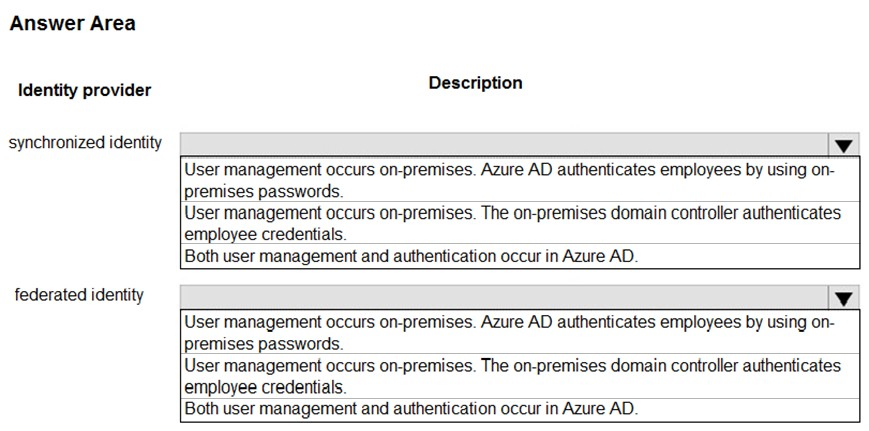
Answer : 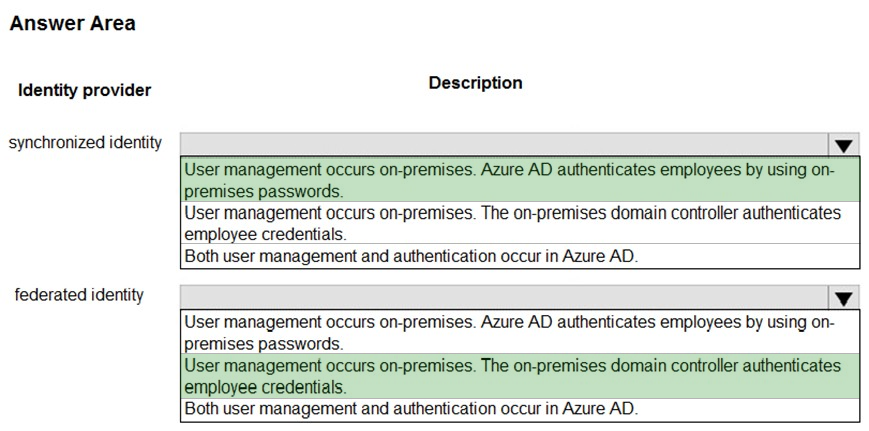
Explanation:
Box1: User management occurs on-premises. Azure AD authenticates employees by using on-premises passwords.
Azure AD Domain Services for hybrid organizations
Organizations with a hybrid IT infrastructure consume a mix of cloud resources and on-premises resources. Such organizations synchronize identity information from their on-premises directory to their Azure AD tenant. As hybrid organizations look to migrate more of their on-premises applications to the cloud, especially legacy directory-aware applications, Azure AD Domain Services can be useful to them.
Example: Litware Corporation has deployed Azure AD Connect, to synchronize identity information from their on-premises directory to their Azure AD tenant. The identity information that is synchronized includes user accounts, their credential hashes for authentication (password hash sync) and group memberships.
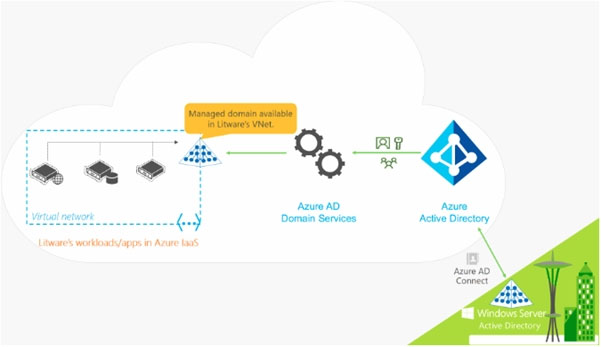
User accounts, group memberships, and credentials from Litware's on-premises directory are synchronized to Azure AD via Azure AD Connect. These user accounts, group memberships, and credentials are automatically available within the managed domain.
Box 2: User management occurs on-premises. The on-promises domain controller authenticates employee credentials.
You can federate your on-premises environment with Azure AD and use this federation for authentication and authorization. This sign-in method ensures that all user authentication occurs on-premises.
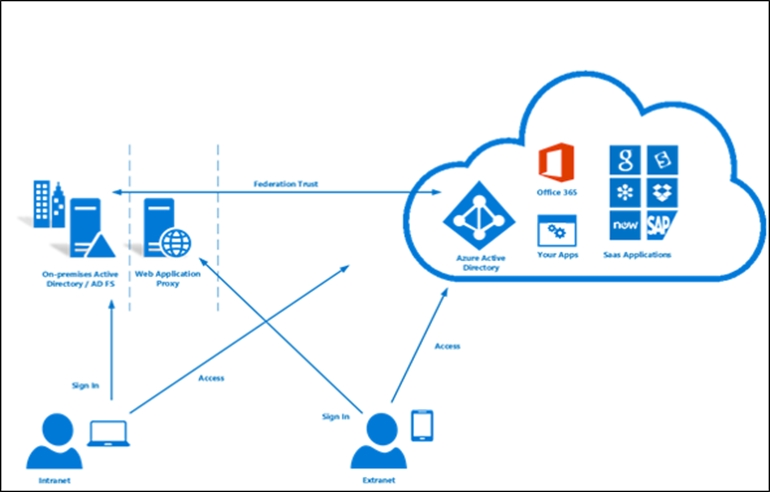
Reference:
https://docs.microsoft.com/en-us/azure/active-directory-domain-services/active-directory-ds-overview https://docs.microsoft.com/en-us/azure/active-directory/hybrid/whatis-fed
Question 11
Note: This question is a part of series of questions that present the same scenario. Each question in the series contains a unique solution that might meet the stated goals. Some question sets might have more than one correct solution, while others might not have a correct solution.
After you answer a question in this section, you will NOT be able to return to it. As a result, these questions will not appear in the review screen.
You have an Azure subscription that contains a resource group named RG1.
You create an Azure Active Directory (Azure AD) group named ResearchUsers that contains the user accounts of all researchers.
You need to recommend a solution that meets the following requirements:
-> The researchers must be allowed to create Azure virtual machines.
-> The researchers must only be able to create Azure virtual machines by using specific Azure Resource Manager templates.
Solution: On RG1, assign a custom role-based access control (RBAC) role to the ResearchUsers group.
Does this meet the goal?
- A. Yes
- B. No
Answer : B
Explanation:
Instead: On RG1, assign the Contributor role to the ResearchUsers group. Create a custom Azure Policy definition and assign the policy to RG1.
Question 12
A company deploys Azure Active Directory (Azure AD) Connect to synchronize identity information from their on-premises Active Directory Domain Services (AD
DS) directory to their Azure AD tenant. The identity information that is synchronized includes user accounts, credential hashes for authentication (password sync), and group memberships. The company plans to deploy several Windows and Linux virtual machines (VMs) to support their applications.
The VMs have the following requirements:
-> Support domain join, LDAP read, LDAP bind, NTLM and Kerberos authentication, and Group Policy.
-> Allow users to sign in to the domain using their corporate credentials and connect remotely to the VM by using Remote Desktop.
You need to support the VM deployment.
Which service should you use?
- A. Azure AD Domain Services
- B. Azure AD Privileged Identity Management
- C. Azure Managed Identity
- D. Active Directory Federation Services (AD FS)
Answer : A
Explanation:
Azure AD Domain Services provides managed domain services such as domain join, group policy, LDAP, Kerberos/NTLM authentication that are fully compatible with Windows Server Active Directory.
Reference:
https://docs.microsoft.com/en-us/azure/active-directory-domain-services/active-directory-ds-overview
Question 13
DRAG DROP -
A company has an existing web application that runs on virtual machines (VMs) in Azure.
You need to ensure that the application is protected from SQL injection attempts and uses a layer-7 load balancer. The solution must minimize disruption to the code for the existing web application.
What should you recommend? To answer, drag the appropriate values to the correct items. Each value may be used once, more than once, or not at all. You may need to drag the split bar between panes or scroll to view content.
NOTE: Each correct selection is worth one point.
Select and Place:
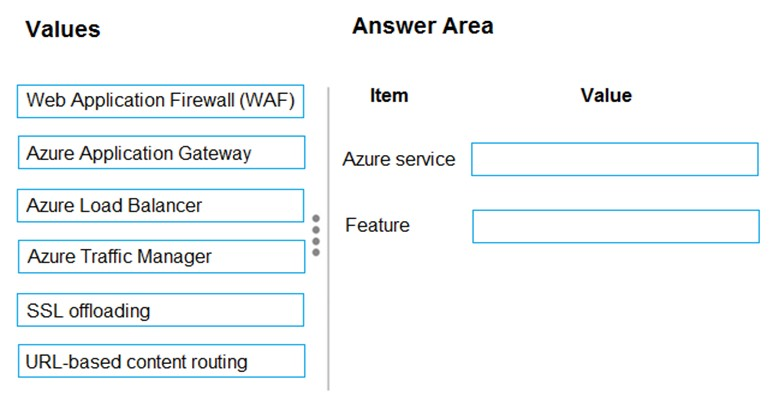
Answer : 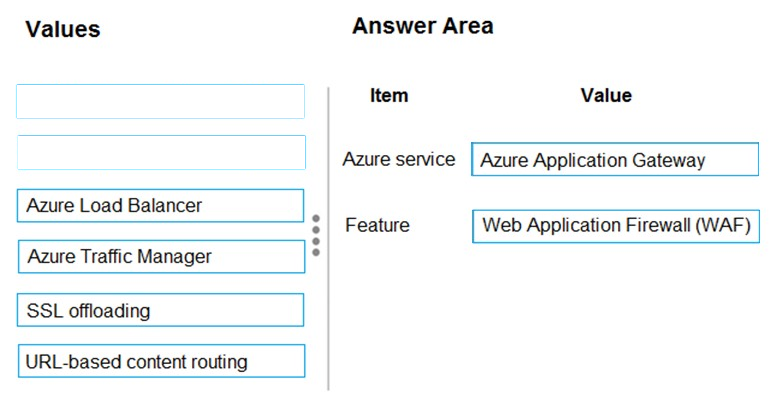
Explanation:
Box 1: Azure Application Gateway
Azure Application Gateway provides an application delivery controller (ADC) as a service. It offers various layer 7 load-balancing capabilities for your applications.
Box 2: Web Application Firwewall (WAF)
Application Gateway web application firewall (WAF) protects web applications from common vulnerabilities and exploits.
This is done through rules that are defined based on the OWASP core rule sets 3.0 or 2.2.9.
There are rules that detects SQL injection attacks.
Reference:
https://docs.microsoft.com/en-us/azure/application-gateway/application-gateway-faq https://docs.microsoft.com/en-us/azure/application-gateway/waf-overview
Question 14
Note: This question is a part of series of questions that present the same scenario. Each question in the series contains a unique solution that might meet the stated goals. Some question sets might have more than one correct solution, while others might not have a correct solution.
After you answer a question in this section, you will NOT be able to return to it. As a result, these questions will not appear in the review screen.
Your company has deployed several virtual machines (VMs) on-premises and to Azure. Azure ExpressRoute has been deployed and configured for on-premises to Azure connectivity.
Several VMs are exhibiting network connectivity issues.
You need to analyze the network traffic to determine whether packets are being allowed or denied to the VMs.
Solution: Use the Azure traffic analytics solution in Azure Log Analytics to analyze the network traffic.
Does the solution meet the goal?
- A. Yes
- B. No
Answer : B
Explanation:
Instead use Azure Network Watcher to run IP flow verify to analyze the network traffic.
Reference:
https://docs.microsoft.com/en-us/azure/network-watcher/network-watcher-monitoring-overview https://docs.microsoft.com/en-us/azure/network-watcher/network-watcher-ip-flow-verify-overview
Question 15
Note: This question is a part of series of questions that present the same scenario. Each question in the series contains a unique solution that might meet the stated goals. Some question sets might have more than one correct solution, while others might not have a correct solution.
After you answer a question in this section, you will NOT be able to return to it. As a result, these questions will not appear in the review screen.
Your company has deployed several virtual machines (VMs) on-premises and to Azure. Azure ExpressRoute has been deployed and configured for on-premises to Azure connectivity.
Several VMs are exhibiting network connectivity issues.
You need to analyze the network traffic to determine whether packets are being allowed or denied to the VMs.
Solution: Use Azure Network Watcher to run IP flow verify to analyze the network traffic.
Does the solution meet the goal?
- A. Yes
- B. No
Answer : A
Explanation:
The Network Watcher Network performance monitor is a cloud-based hybrid network monitoring solution that helps you monitor network performance between various points in your network infrastructure. It also helps you monitor network connectivity to service and application endpoints and monitor the performance of
Azure ExpressRoute.
Note:
IP flow verify checks if a packet is allowed or denied to or from a virtual machine. The information consists of direction, protocol, local IP, remote IP, local port, and remote port. If the packet is denied by a security group, the name of the rule that denied the packet is returned. While any source or destination IP can be chosen,
IP flow verify helps administrators quickly diagnose connectivity issues from or to the internet and from or to the on-premises environment.
IP flow verify looks at the rules for all Network Security Groups (NSGs) applied to the network interface, such as a subnet or virtual machine NIC. Traffic flow is then verified based on the configured settings to or from that network interface. IP flow verify is useful in confirming if a rule in a Network Security Group is blocking ingress or egress traffic to or from a virtual machine.
Reference:
https://docs.microsoft.com/en-us/azure/network-watcher/network-watcher-monitoring-overview https://docs.microsoft.com/en-us/azure/network-watcher/network-watcher-ip-flow-verify-overview